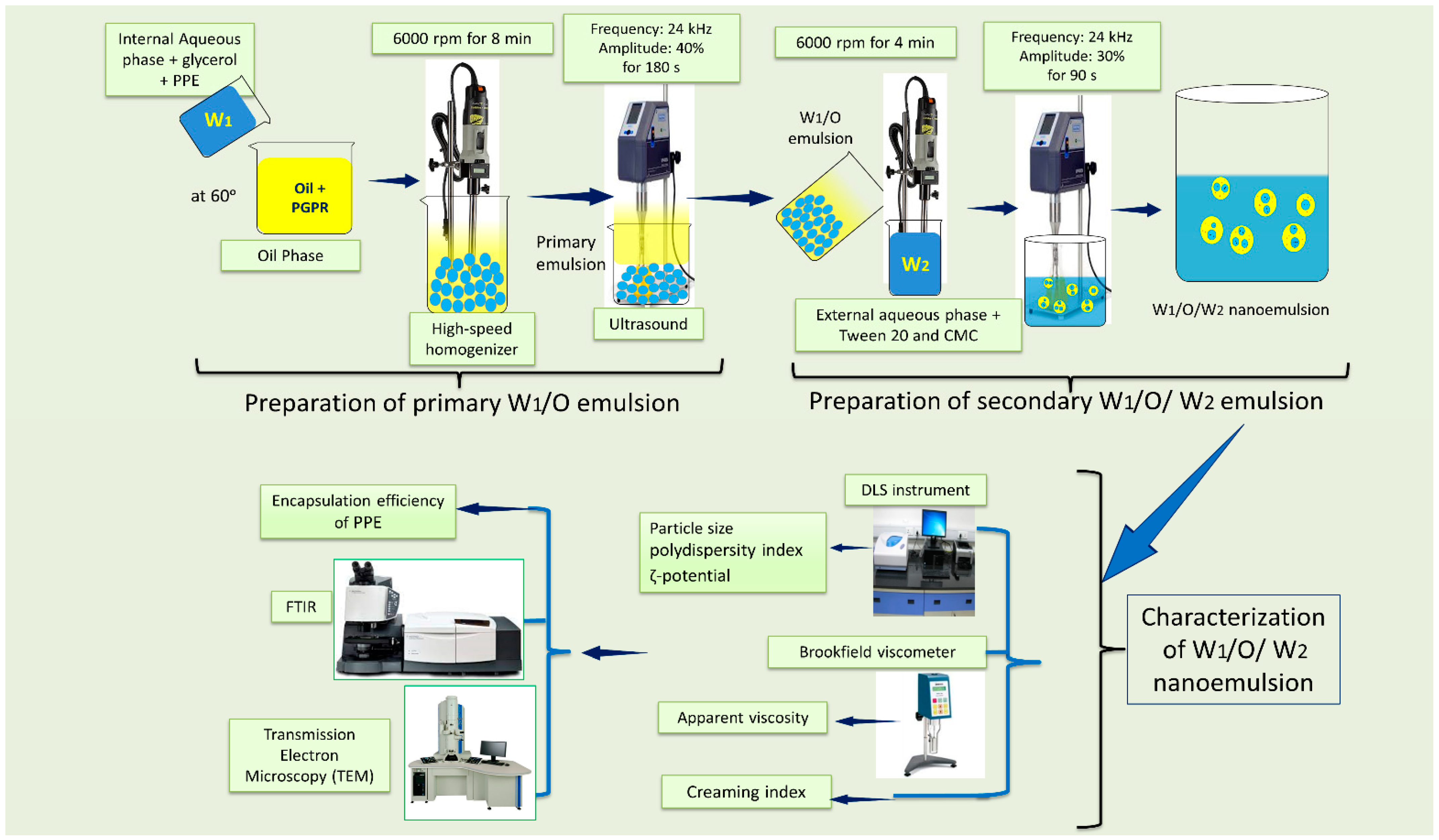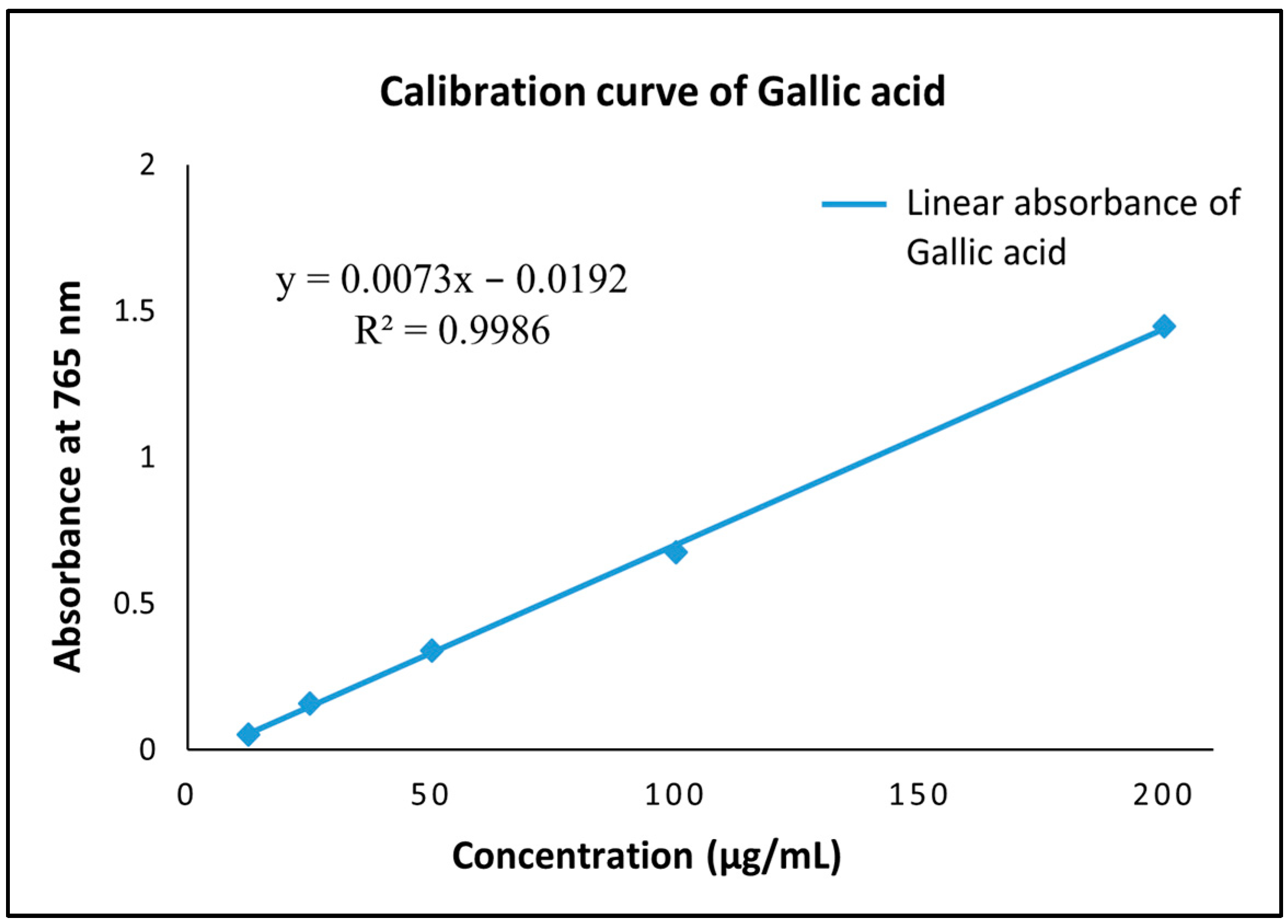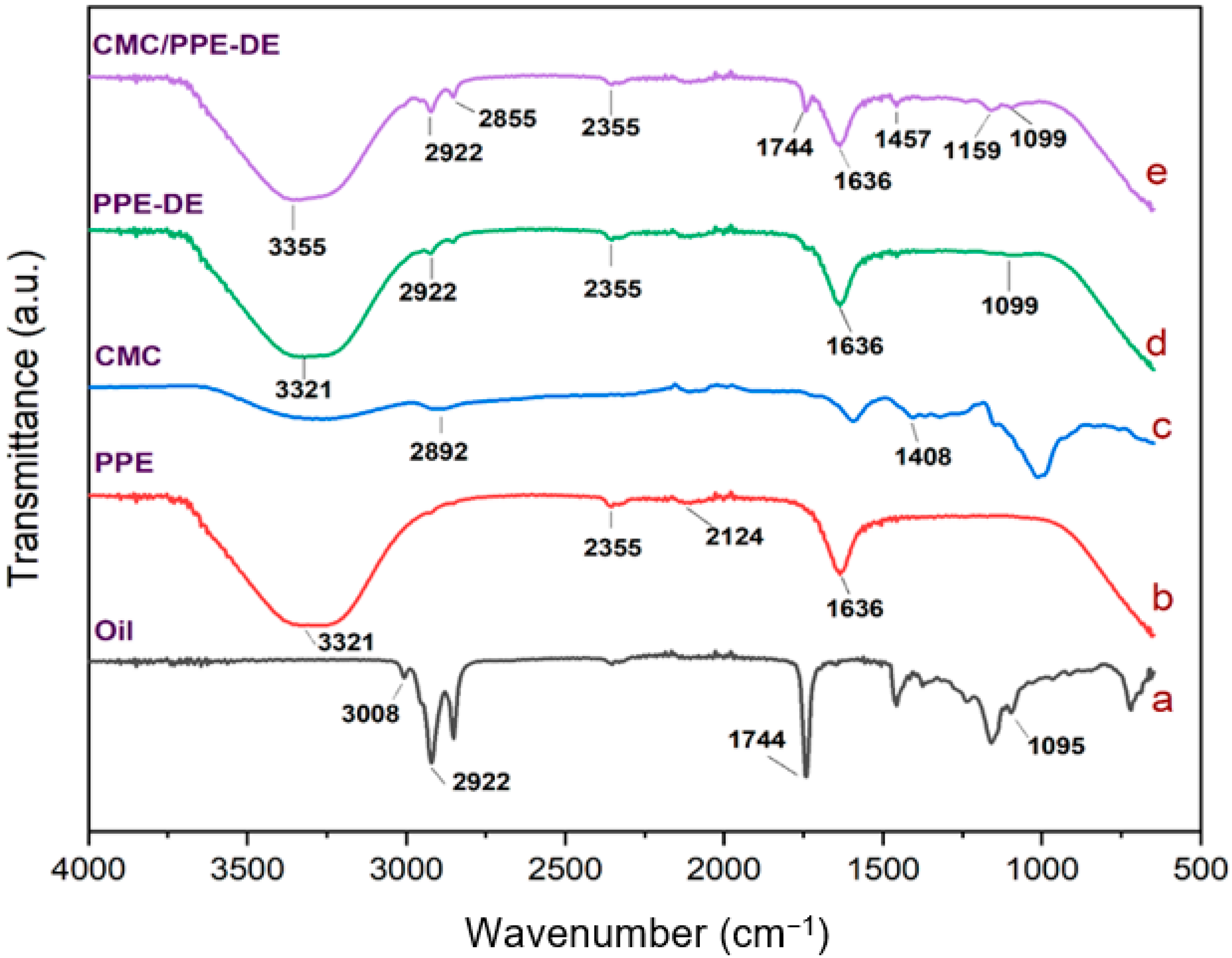Enhancement of the Stability of Encapsulated Pomegranate (Punica granatum L.) Peel Extract by Double Emulsion with Carboxymethyl Cellulose
Abstract
:1. Introduction
2. Materials and Methods
2.1. Materials
2.2. Preparation of Pomegranate Peel Powder
2.3. Preparation of PPE
2.4. Preparations of PPE-DE
2.5. Emulsion Characterization
2.5.1. Particle Size, Polydispersity Index (PDI), and ζ Potential Measurements
2.5.2. Viscosity Measurement
2.5.3. Creaming Index (CI)
2.5.4. FTIR
2.5.5. Measurement of EE
2.5.6. TEM
2.6. Statistical Analysis
3. Results and Discussion
3.1. Droplet Size Distribution and ζ Potential
3.2. Viscosity and Creaming Index
3.3. FTIR Analysis
3.4. Encapsulation Efficiency
3.5. Morphology of W1/O/W2 Nanoemulsions
4. Conclusions
Author Contributions
Funding
Institutional Review Board Statement
Informed Consent Statement
Data Availability Statement
Acknowledgments
Conflicts of Interest
References
- El-Hadary, A.; Taha, M. Pomegranate peel methanolic-extract improves the shelf-life of edible-oils under accelerated oxidation conditions. Food Sci. Nutr. 2020, 8, 1798–1811. [Google Scholar] [CrossRef]
- Pienaar, L. The Economic Contribution of South Africa’s Pomegranate Industry; Technical Report for Western Cape Department of Agriculture: Elsenburg, South Africa, 2021. [Google Scholar]
- Kahramanoglu, I.; Usanmaz, S. Pomegranate Production and Marketing. Pomegranates 2016. [Google Scholar] [CrossRef]
- Kaderides, K.; Kyriakoudi, A.; Mourtzinos, I.; Goula, A.M. Potential of pomegranate peel extract as a natural additive in foods. Trends Food Sci. Technol. 2021, 115, 380–390. [Google Scholar] [CrossRef]
- Çam, M.; Içyer, N.C.; Erdoğan, F. Pomegranate peel phenolics: Microencapsulation, storage stability and potential ingredient for functional food development. Food Sci. Technol. 2014, 55, 117–123. [Google Scholar] [CrossRef]
- Roy, S.; Lingampeta, P. Solid Wastes of Fruits Peels as Source of Low Cost Broad Spectrum Natural Antimicrobial Compounds- Furanone, Furfural and Benezenetriol. Int. J. Res. Eng. Technol. 2014, 3, 273–279. [Google Scholar] [CrossRef]
- Kaderides, K.; Mourtzinos, I.; Goula, A.M. Stability of pomegranate peel polyphenols encapsulated in orange juice industry by-product and their incorporation in cookies. Food Chem. 2019, 310, 125849. [Google Scholar] [CrossRef]
- Adiga, S.; Trivedi, P.; Ravichandra, V.; Deb, D.; Mehta, F. Effect of Punica granatum peel extract on learning and memory in rats. Asian Pac. J. Trop. Med. 2010, 3, 687–690. [Google Scholar] [CrossRef]
- Ismail, T.; Sestili, P.; Akhtar, S. Pomegranate peel and fruit extracts: A review of potential anti-inflammatory and anti-infective effects. J. Ethnopharmacol. 2012, 143, 397–405. [Google Scholar] [CrossRef]
- Aqil, F.; Munagala, R.; Vadhanam, M.V.; Kausar, H.; Jeyabalan, J.; Schultz, D.J.; Gupta, R.C. Anti-proliferative activity and protection against oxidative DNA damage by punicalagin isolated from pomegranate husk. Food Res. Int. 2012, 49, 345–353. [Google Scholar] [CrossRef] [Green Version]
- Gharzouli, K.; Khennouf, S.; Amira, S.; Gharzouli, A. Effects of aqueous extracts fromQuercus ilex l. root bark, Punica granatum l. fruit peel andArtemisia herba-alba Asso leaves on ethanol-induced gastric damage in rats. Phytother. Res. 1999, 13, 42–45. [Google Scholar] [CrossRef]
- Hayouni, E.; Miled, K.; Boubaker, S.; Bellasfar, Z.; Abedrabba, M.; Iwaski, H.; Oku, H.; Matsui, T.; Limam, F.; Hamdi, M. Hydroalcoholic extract based-ointment from Punica granatum L. peels with enhanced in vivo healing potential on dermal wounds. Phytomedicine 2011, 18, 976–984. [Google Scholar] [CrossRef]
- Munin, A.; Edwards-Lévy, F. Encapsulation of Natural Polyphenolic Compounds; A Review. Pharmaceutics 2011, 3, 793–829. [Google Scholar] [CrossRef] [Green Version]
- Medina-Pérez, G.; Estefes-Duarte, J.A.; Afanador-Barajas, L.N.; Fernández-Luqueño, F.; Zepeda-Velázquez, A.P.; Franco-Fernández, M.J.; Peláez-Acero, A.; Campos-Montiel, R.G. Encapsulation Preserves Antioxidant and Antidiabetic Activities of Cactus Acid Fruit Bioactive Compounds Under Simulated Digestion Conditions. Molecules 2020, 25, 5736. [Google Scholar] [CrossRef]
- Šaponjac, V.T.; Ćetković, G.; Čanadanović-Brunet, J.; Pajin, B.; Djilas, S.; Petrović, J.; Lončarević, I.; Stajčić, S.; Vulić, J. Sour cherry pomace extract encapsulated in whey and soy proteins: Incorporation in cookies. Food Chem. 2016, 207, 27–33. [Google Scholar] [CrossRef]
- Salgado, J.M.; Ferreira, T.R.B.; Biazotto, F.D.O.; Dias, C.T.D.S. Increased Antioxidant Content in Juice Enriched with Dried Extract of Pomegranate (Punica granatum) Peel. Mater. Veg. 2012, 67, 39–43. [Google Scholar] [CrossRef]
- Niknam, S.M.; Escudero, I.; Benito, J.M. Formulation and Preparation of Water-In-Oil-In-Water Emulsions Loaded with a Phenolic-Rich Inner Aqueous Phase by Application of High Energy Emulsification Methods. Foods 2020, 9, 1411. [Google Scholar] [CrossRef]
- Echeverria, F.; Patino, P.A.J.; Castro-Sepulveda, M.; Bustamante, A.; Concha, P.A.G.; Poblete-Aro, C.; Valenzuela, R.; Garcia-Diaz, D.F. Microencapsulated pomegranate peel extract induces mitochondrial complex IV activity and prevents mitochondrial cristae alteration in brown adipose tissue in mice fed on a high-fat diet. Br. J. Nutr. 2020, 126, 825–836. [Google Scholar] [CrossRef]
- Sandhya, S.; Khamrui, K.; Prasad, W.; Kumar, M. Preparation of pomegranate peel extract powder and evaluation of its effect on functional properties and shelf life of curd. LWT 2018, 92, 416–421. [Google Scholar] [CrossRef]
- Saadat, S.; Emam-Djomeh, Z.; Askari, G. Antibacterial and Antioxidant Gelatin Nanofiber Scaffold Containing Ethanol Extract of Pomegranate Peel: Design, Characterization and In Vitro Assay. Food Bioprocess Technol. 2021, 14, 935–944. [Google Scholar] [CrossRef]
- Surendhiran, D.; Li, C.; Cui, H.; Lin, L. Fabrication of high stability active nanofibers encapsulated with pomegranate peel extract using chitosan/PEO for meat preservation. Food Packag. Shelf Life 2019, 23, 100439. [Google Scholar] [CrossRef]
- Aditya, N.; Aditya, S.; Yang, H.-J.; Kim, H.W.; Park, S.O.; Lee, J.; Ko, S. Curcumin and catechin co-loaded water-in-oil-in-water emulsion and its beverage application. J. Funct. Foods 2015, 15, 35–43. [Google Scholar] [CrossRef]
- Kaimainen, M.; Marze, S.; Järvenpää, E.; Anton, M.; Huopalahti, R. Encapsulation of betalain into w/o/w double emulsion and release during in vitro intestinal lipid digestion. Food Sci. Technol. 2015, 60, 899–904. [Google Scholar] [CrossRef]
- Silva, M.; Chandrapala, J. Ultrasonic Emulsification of Milk Proteins Stabilized Primary and Double Emulsions: A Review. Food Rev. Int. 2021, 1–23. [Google Scholar] [CrossRef]
- Teixé-Roig, J.; Oms-Oliu, G.; Velderrain-Rodríguez, G.R.; Odriozola-Serrano, I.; Martín-Belloso, O. The Effect of Sodium Carboxymethylcellulose on the Stability and Bioaccessibility of Anthocyanin Water-in-Oil-in-Water Emulsions. Food Bioprocess Technol. 2018, 11, 2229–2241. [Google Scholar] [CrossRef]
- Aditya, N.; Aditya, S.; Yang, H.; Kim, H.W.; Park, S.O.; Ko, S. Co-delivery of hydrophobic curcumin and hydrophilic catechin by a water-in-oil-in-water double emulsion. Food Chem. 2015, 173, 7–13. [Google Scholar] [CrossRef]
- Gharehbeglou, P.; Jafari, S.M.; Homayouni, A.; Hamishekar, H.; Mirzaei, H. Fabrication of double W1/O/W2 nano-emulsions loaded with oleuropein in the internal phase (W1) and evaluation of their release rate. Food Hydrocoll. 2018, 89, 44–55. [Google Scholar] [CrossRef]
- Martins, C.; Higaki, N.T.F.; Montrucchio, D.P.; de Oliveira, C.F.; Gomes, M.L.S.; Miguel, M.D.; Miguel, O.G.; Zanin, S.M.W.; Dias, J.D.F.G. Development of W1/O/W2 emulsion with gallic acid in the internal aqueous phase. Food Chem. 2020, 314, 126174. [Google Scholar] [CrossRef]
- Rodríguez, G.V.; Acevedo-Fani, A.; González-Aguilar, G.A.; Martín-Belloso, O. Encapsulation and stability of a phenolic-rich extract from mango peel within water-in-oil-in-water emulsions. J. Funct. Foods 2019, 56, 65–73. [Google Scholar] [CrossRef]
- Mohammadi, A.; Jafari, S.M.; Assadpour, E.; Esfanjani, A.F. Nano-encapsulation of olive leaf phenolic compounds through WPC–pectin complexes and evaluating their release rate. Int. J. Biol. Macromol. 2015, 82, 816–822. [Google Scholar] [CrossRef]
- Estévez, M.; Güell, C.; De Lamo-Castellví, S.; Ferrando, M. Encapsulation of grape seed phenolic-rich extract within W/O/W emulsions stabilized with complexed biopolymers: Evaluation of their stability and release. Food Chem. 2018, 272, 478–487. [Google Scholar] [CrossRef]
- Harimurti, N.; Nasikin, M.; Mulia, K. Water-in-Oil-in-Water Nanoemulsions Containing Temulawak (Curcuma xanthorriza Roxb) and Red Dragon Fruit (Hylocereus polyrhizus) Extracts. Molecules 2021, 26, 196. [Google Scholar] [CrossRef] [PubMed]
- Bamba, B.S.B.; Shi, J.; Tranchant, C.C.; Xue, S.J.; Forney, C.F.; Lim, L.-T.; Xu, W.; Xu, G. Coencapsulation of Polyphenols and Anthocyanins from Blueberry Pomace by Double Emulsion Stabilized by Whey Proteins: Effect of Homogenization Parameters. Molecules 2018, 23, 2525. [Google Scholar] [CrossRef] [PubMed] [Green Version]
- Delfanian, M.; Razavi, S.M.; Khodaparast, M.H.H.; Kenari, R.E.; Golmohammadzadeh, S. Influence of main emulsion components on the physicochemical and functional properties of W/O/W nano-emulsion: Effect of polyphenols, Hi-Cap, basil seed gum, soy and whey protein isolates. Food Res. Int. 2018, 108, 136–143. [Google Scholar] [CrossRef]
- Mazzucotelli, C.A.; González-Aguilar, G.A.; Villegas-Ochoa, M.A.; Domínguez-Avila, A.J.; Ansorena, M.R.; Di Scala, K.C. Chemical characterization and functional properties of selected leafy vegetables for innovative mixed salads. J. Food Biochem. 2017, 42, e12461. [Google Scholar] [CrossRef] [Green Version]
- Akhtar, M.; Murray, B.S.; Afeisume, E.I.; Khew, S.H. Encapsulation of flavonoid in multiple emulsion using spinning disc reactor technology. Food Hydrocoll. 2014, 34, 62–67. [Google Scholar] [CrossRef]
- Huang, H.; Belwal, T.; Liu, S.; Duan, Z.; Luo, Z. Novel multi-phase nano-emulsion preparation for co-loading hydrophilic arbutin and hydrophobic coumaric acid using hydrocolloids. Food Hydrocoll. 2019, 93, 92–101. [Google Scholar] [CrossRef]
- Lutz, R.; Aserin, A.; Wicker, L.; Garti, N. Release of electrolytes from W/O/W double emulsions stabilized by a soluble complex of modified pectin and whey protein isolate. Colloids Surf. B Biointerfaces 2009, 74, 178–185. [Google Scholar] [CrossRef]
- Suárez, M.A.; Gutiérrez, G.; Coca, J.; Pazos, C. Geometric parameters influencing production of O/W emulsions using flat metallic membranes and scale-up. J. Membr. Sci. 2013, 430, 140–149. [Google Scholar] [CrossRef]
- Silva, W.; Torres-Gatica, M.F.; Oyarzun-Ampuero, F.; Silva-Weiss, A.; Robert, P.; Cofrades, S.; Giménez, B. Double emulsions as potential fat replacers with gallic acid and quercetin nanoemulsions in the aqueous phases. Food Chem. 2018, 253, 71–78. [Google Scholar] [CrossRef]
- Wu, Z.; Wu, J.; Zhang, R.; Yuan, S.; Lu, Q.; Yu, Y. Colloid properties of hydrophobic modified alginate: Surface tension, ζ-potential, viscosity and emulsification. Carbohydr. Polym. 2018, 181, 56–62. [Google Scholar] [CrossRef]
- Zimmermann, E. Electrolyte- and pH-stabilities of aqueous solid lipid nanoparticle (SLN™) dispersions in artificial gastrointestinal media. Eur. J. Pharm. Biopharm. 2001, 52, 203–210. [Google Scholar] [CrossRef]
- Lamba, H.; Sathish, K.; Sabikhi, L. Double Emulsions: Emerging Delivery System for Plant Bioactives. Food Bioprocess Technol. 2015, 8, 709–728. [Google Scholar] [CrossRef]
- Matos, M.; Gutiérrez, G.; Coca, J.; Pazos, C. Preparation of water-in-oil-in-water (W1/O/W2) double emulsions containing trans-resveratrol. Colloids Surf. A Physicochem. Eng. Asp. 2014, 442, 69–79. [Google Scholar] [CrossRef]
- Dima, C.; Dima, S. Water-in-oil-in-water double emulsions loaded with chlorogenic acid: Release mechanisms and oxidative stability. J. Microencapsul. 2018, 35, 584–599. [Google Scholar] [CrossRef]
- Ye, A.; Hemar, Y.; Singh, H. Influence of Polysaccharides on the Rate of Coalescence in Oil-in-Water Emulsions Formed with Highly Hydrolyzed Whey Proteins. J. Agric. Food Chem. 2004, 52, 5491–5498. [Google Scholar] [CrossRef]
- Rohman, A.; Man, Y.B.C. Quantification and Classification of Corn and Sunflower Oils as Adulterants in Olive Oil Using Chemometrics and FTIR Spectra. Sci. World J. 2012, 2012, 1–6. [Google Scholar] [CrossRef] [PubMed] [Green Version]
- Pirsa, S.; Sani, I.K.; PirouziFard, M.K.; Erfani, A. Smart film based on chitosan/Melissa officinalis essences/ pomegranate peel extract to detect cream cheeses spoilage. Food Addit. Contam. Part A 2020, 37, 634–648. [Google Scholar] [CrossRef] [PubMed]
- Ghorai, S.; Sarkar, A.; Raoufi, M.; Panda, A.B.; Schönherr, H.; Pal, S. Enhanced Removal of Methylene Blue and Methyl Violet Dyes from Aqueous Solution Using a Nanocomposite of Hydrolyzed Polyacrylamide Grafted Xanthan Gum and Incorporated Nanosilica. ACS Appl. Mater. Interfaces 2014, 6, 4766–4777. [Google Scholar] [CrossRef]
- Jafirin, S.; Ahmad, I.; Ahmad, A. Composite polymer electrolytes based on MG49 and carboxymethyl cellulose from kenaf. In AIP Conference Proceedings; American Institute of Physics: College Park, MD, USA, 2013; pp. 822–828. [Google Scholar] [CrossRef] [Green Version]
- Ding, S.; Serra, C.A.; Vandamme, T.F.; Yu, W.; Anton, N. Double emulsions prepared by two–step emulsification: History, state-of-the-art and perspective. J. Control Release 2018, 295, 31–49. [Google Scholar] [CrossRef]
- Perez-Moral, N.; Watt, S.; Wilde, P. Comparative study of the stability of multiple emulsions containing a gelled or aqueous internal phase. Food Hydrocoll. 2014, 42, 215–222. [Google Scholar] [CrossRef]
- Márquez, A.L.; Medrano, A.; Panizzolo, L.A.; Wagner, J.R. Effect of calcium salts and surfactant concentration on the stability of water-in-oil (w/o) emulsions prepared with polyglycerol polyricinoleate. J. Colloid Interface Sci. 2010, 341, 101–108. [Google Scholar] [CrossRef] [PubMed]
- Wang, J.; Shi, A.; Agyei, D.; Wang, Q. Formulation of water-in-oil-in-water (W/O/W) emulsions containing trans-resveratrol. RSC Adv. 2017, 7, 35917–35927. [Google Scholar] [CrossRef] [Green Version]
- Schwarz, J.C.; Klang, V.; Karall, S.; Mahrhauser, D.; Resch, G.P.; Valenta, C. Optimisation of multiple W/O/W nanoemulsions for dermal delivery of aciclovir. Int. J. Pharm. 2012, 435, 69–75. [Google Scholar] [CrossRef]
- Yang, L.; Qin, X.; Kan, J.; Liu, X.; Zhong, J. Improving the Physical and Oxidative Stability of Emulsions Using Mixed Emulsifiers: Casein-Octenyl Succinic Anhydride Modified Starch Combinations. Nanomaterials 2019, 9, 1018. [Google Scholar] [CrossRef] [PubMed] [Green Version]








| Sample | Mean Diameter (nm) | Standard Deviation (nm) | Chai Square | Variation PDI |
|---|---|---|---|---|
| Blank-DE | 304.1 | 145.1 | 12.157 | 0.228 |
| PPE-DE | 259.2 | 137.4 | 1.091 | 0.281 |
| CMC+PPE-DE | 264.5 | 108.7 | 4.793 | 0.169 |
| Sample | Avg. Zeta Potential (mV) | Cell Current (mA) | Avg. Mobility (M. U.) | Frequency Shift (Hz) |
|---|---|---|---|---|
| Blank-DE | −19.41 | 0.09 | −1.36 | −2.42 |
| PPE-DE | −45.81 | 0.06 | −3.20 | −6.36 |
| CMC/PPE-DE | −25.30 | 0.13 | −6.36 | −2.85 |
| Sample | Viscosity (cP) | Creaming Index (% CI) | Thermodynamical Stability | |
|---|---|---|---|---|
| 20 Days | 30 Days | |||
| Blank-DE | 3.4 ± 0.07 b | 51.87 ± 0.98 a | 57.22 ± 1.18 a | Instable |
| PPE-DE | 3.6 ± 0.10 a | 1.55 ± 0.11 b | 1.55 ± 0.11 b | Stable |
| CMC/PPE-DE | 3.7 ± 0.12 a | 0.52 ± 0.06 b | 0.52 ± 0.06 b | Stable |
Publisher’s Note: MDPI stays neutral with regard to jurisdictional claims in published maps and institutional affiliations. |
© 2022 by the authors. Licensee MDPI, Basel, Switzerland. This article is an open access article distributed under the terms and conditions of the Creative Commons Attribution (CC BY) license (https://creativecommons.org/licenses/by/4.0/).
Share and Cite
Hady, E.; Youssef, M.; Aljahani, A.H.; Aljumayi, H.; Ismail, K.A.; El-Damaty, E.-S.; Sami, R.; El-Sharnouby, G. Enhancement of the Stability of Encapsulated Pomegranate (Punica granatum L.) Peel Extract by Double Emulsion with Carboxymethyl Cellulose. Crystals 2022, 12, 622. https://doi.org/10.3390/cryst12050622
Hady E, Youssef M, Aljahani AH, Aljumayi H, Ismail KA, El-Damaty E-S, Sami R, El-Sharnouby G. Enhancement of the Stability of Encapsulated Pomegranate (Punica granatum L.) Peel Extract by Double Emulsion with Carboxymethyl Cellulose. Crystals. 2022; 12(5):622. https://doi.org/10.3390/cryst12050622
Chicago/Turabian StyleHady, Essam, Mahmoud Youssef, Amani H. Aljahani, Huda Aljumayi, Khadiga Ahmed Ismail, El-Sayed El-Damaty, Rokkaya Sami, and Gamal El-Sharnouby. 2022. "Enhancement of the Stability of Encapsulated Pomegranate (Punica granatum L.) Peel Extract by Double Emulsion with Carboxymethyl Cellulose" Crystals 12, no. 5: 622. https://doi.org/10.3390/cryst12050622
APA StyleHady, E., Youssef, M., Aljahani, A. H., Aljumayi, H., Ismail, K. A., El-Damaty, E.-S., Sami, R., & El-Sharnouby, G. (2022). Enhancement of the Stability of Encapsulated Pomegranate (Punica granatum L.) Peel Extract by Double Emulsion with Carboxymethyl Cellulose. Crystals, 12(5), 622. https://doi.org/10.3390/cryst12050622









